Abstract
A total of 123 patients with neonatal liver disease without extrahepatic bile duct obstruction or arteriohepatic dysplasia have been studied for six to 18 years. Idiopathic neonatal hepatitis, present in 73 babies, carried a high mortality due to liver failure (18%), septicaemia (6%), and associated defects (14%), especially in the first year of life (25%). Progression to chronic liver disease in non-familial idiopathic cases occurred in three of 40 reviewed patients. Only 12 of these children were completely healthy, the remainder having other permanent disabilities (57%). Four of nine familial cases of idiopathic neonatal hepatitis died in the first 12 months of life as did two of the four reviewed survivors. Progression to chronic liver disease or to death was a continuous process without any interval of recovery in all but one of these patients. Among patients with a presumed infective cause, cytomegalovirus infection caused a particularly benign form of neonatal hepatitis but was a frequent cause of brain damage or other disabilities. Babies who survived other infective liver diseases showed complete healing of the liver damage. Neonatal liver disease associated with alpha 1 antitrypsin deficiency progressed to death or chronic liver disease in three of nine patients and was not associated with a paucity of interlobular bile ducts.
Full text
PDF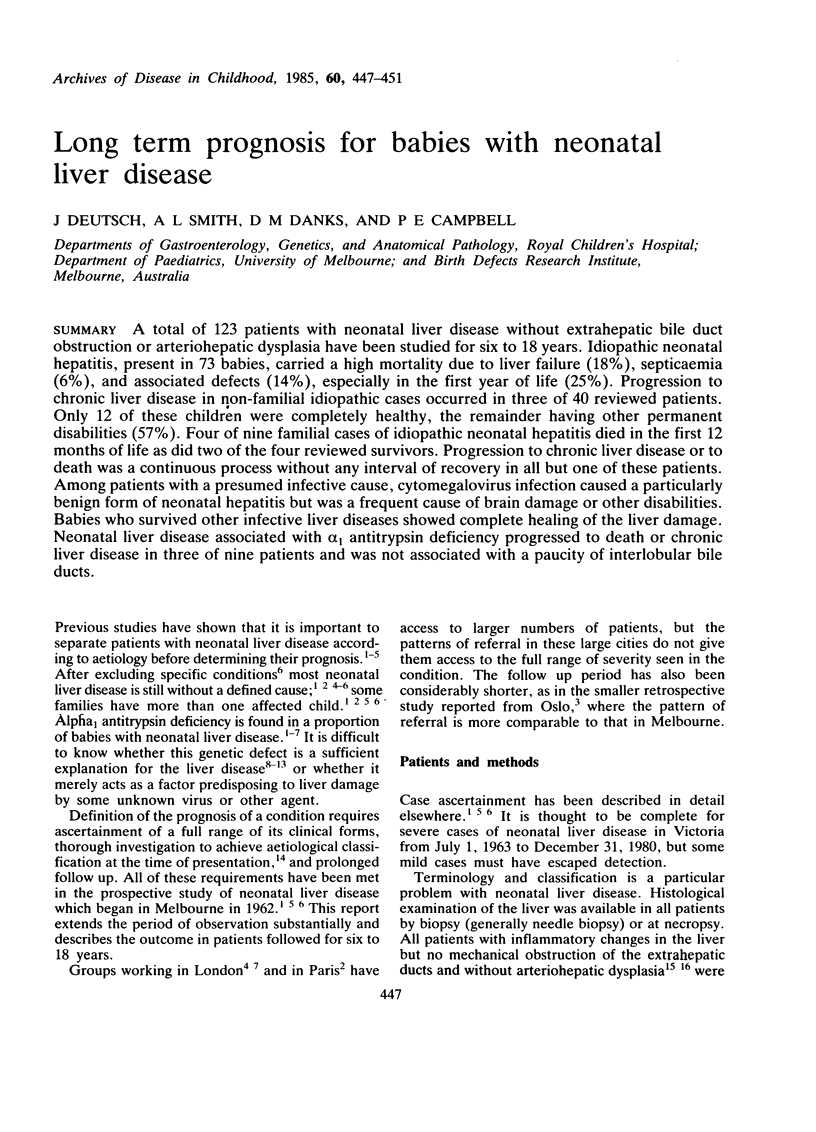
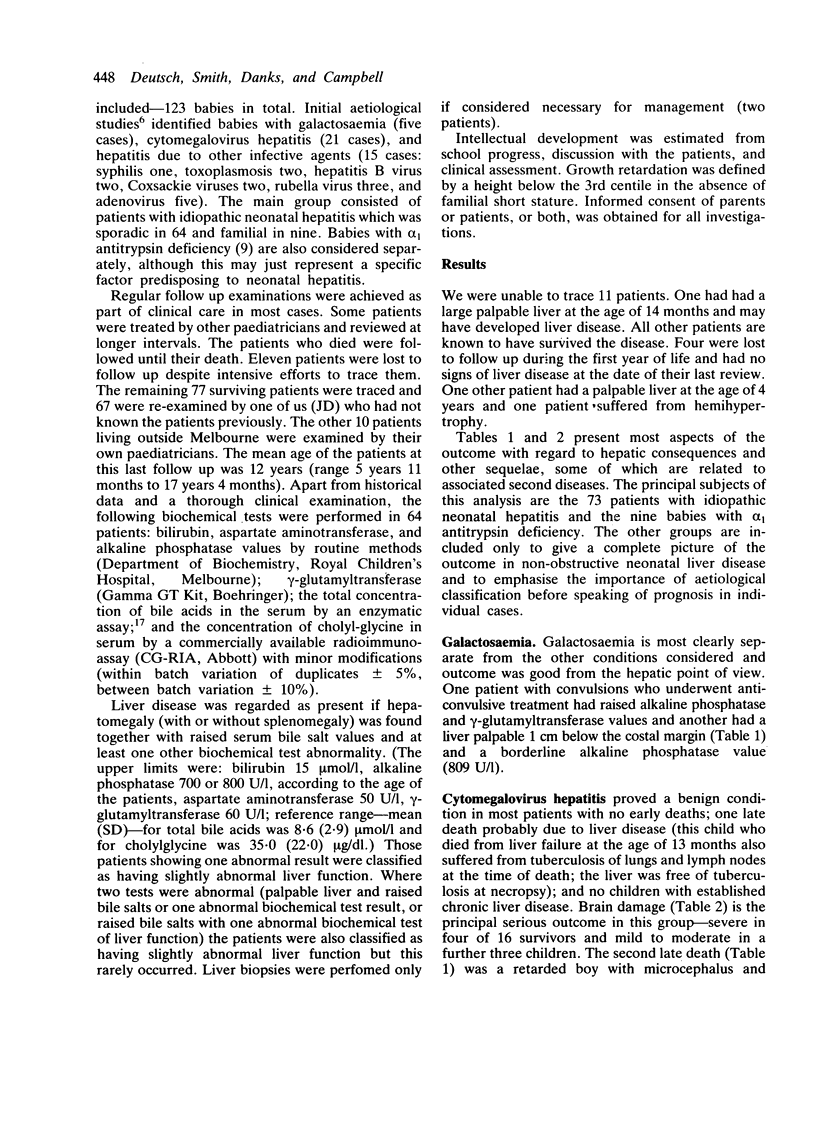
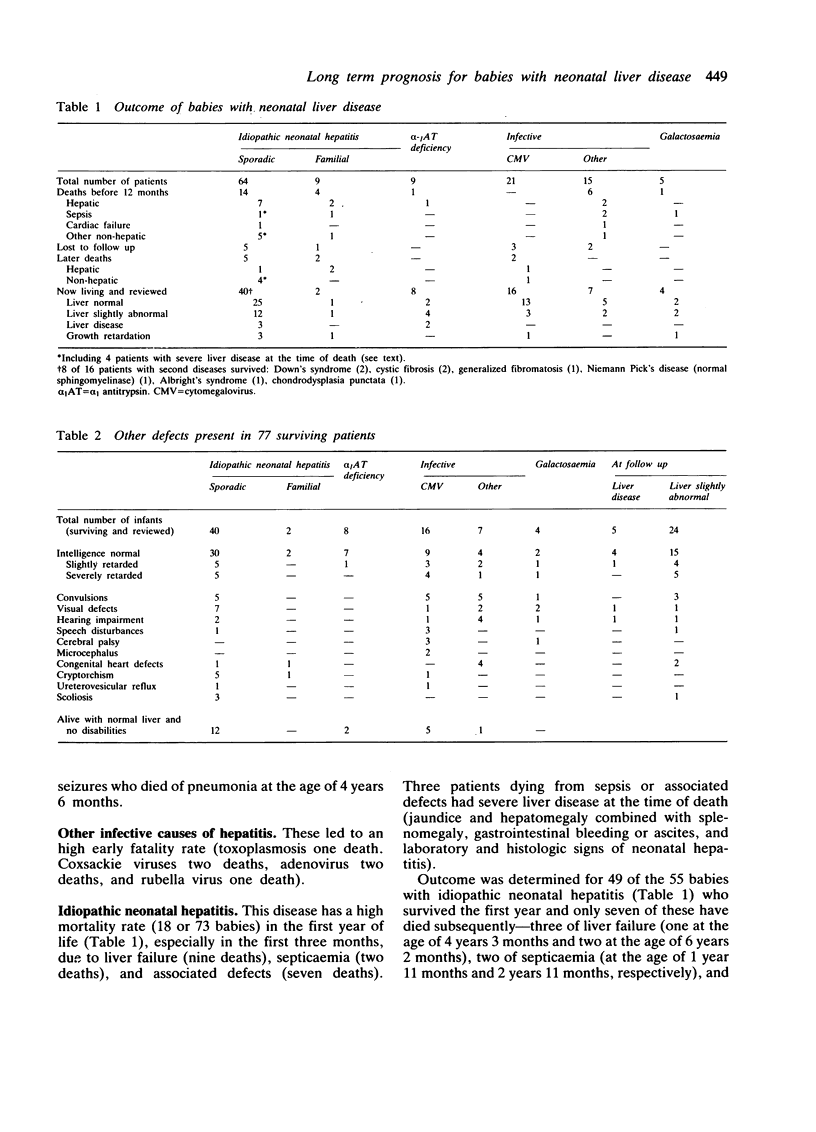
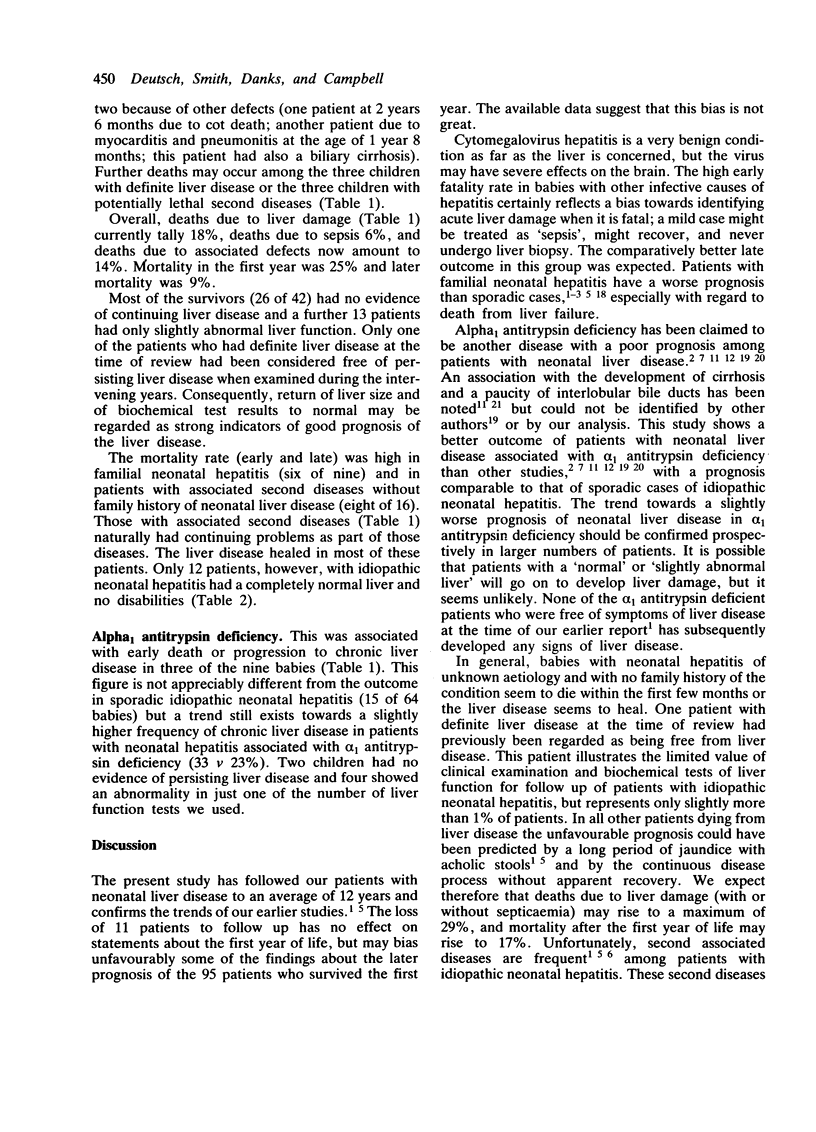
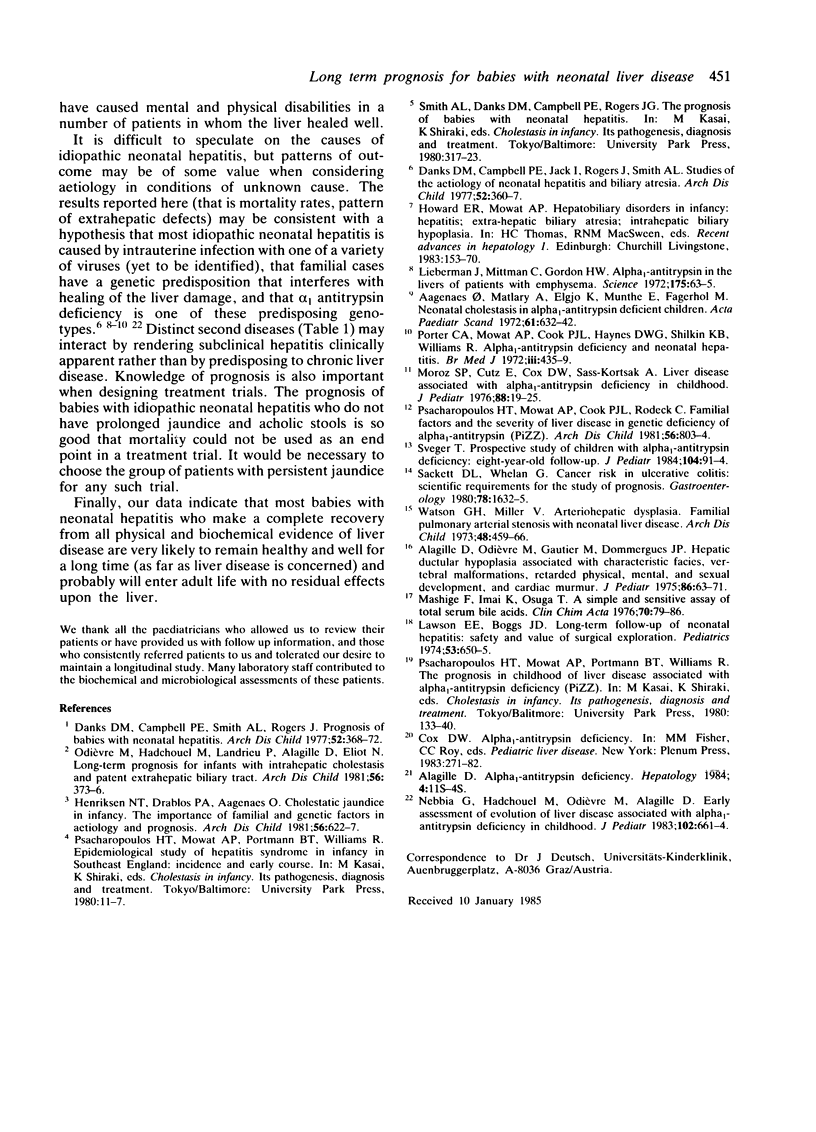
Selected References
These references are in PubMed. This may not be the complete list of references from this article.
- Aagenaes O., Matlary A., Elgjo K., Munthe E., Fagerhol M. Neonatal cholestasis in alpha-1-antitrypsin deficient children. Clinical, genetic, histological and immunohistochemical findings. Acta Paediatr Scand. 1972 Nov;61(6):632–642. doi: 10.1111/j.1651-2227.1972.tb15960.x. [DOI] [PubMed] [Google Scholar]
- Alagille D., Odièvre M., Gautier M., Dommergues J. P. Hepatic ductular hypoplasia associated with characteristic facies, vertebral malformations, retarded physical, mental, and sexual development, and cardiac murmur. J Pediatr. 1975 Jan;86(1):63–71. doi: 10.1016/s0022-3476(75)80706-2. [DOI] [PubMed] [Google Scholar]
- Cuthbert J. A., Pak C. Y., Zerwekh J. E., Glass K. D., Combes B. Bone disease in primary biliary cirrhosis: increased bone resorption and turnover in the absence of osteoporosis or osteomalacia. Hepatology. 1984 Jan-Feb;4(1):1–8. doi: 10.1002/hep.1840040101. [DOI] [PubMed] [Google Scholar]
- Danks D. M., Campbell P. E., Jack I., Rogers J., Smith A. L. Studies of the aetiology of neonatal hepatitis and biliary atresia. Arch Dis Child. 1977 May;52(5):360–367. doi: 10.1136/adc.52.5.360. [DOI] [PMC free article] [PubMed] [Google Scholar]
- Danks D. M., Campbell P. E., Smith A. L., Rogers J. Prognosis of babies with neonatal hepatitis. Arch Dis Child. 1977 May;52(5):368–372. doi: 10.1136/adc.52.5.368. [DOI] [PMC free article] [PubMed] [Google Scholar]
- Henriksen N. T., Drabløs P. A., Aagenaes O. Cholestatic jaundice in infancy. The importance of familial and genetic factors in aetiology and prognosis. Arch Dis Child. 1981 Aug;56(8):622–627. doi: 10.1136/adc.56.8.622. [DOI] [PMC free article] [PubMed] [Google Scholar]
- Lawson E. E., Boggs J. D. Long-term follow-up of neonatal hepatitis: safety and value of surgical exploration. Pediatrics. 1974 May;53(5):650–655. [PubMed] [Google Scholar]
- Lieberman J., Mittman C., Gordon H. W. Alpha 1 antitrypsinin the livers of patients with emphysema. Science. 1972 Jan 7;175(4017):63–65. doi: 10.1126/science.175.4017.63. [DOI] [PubMed] [Google Scholar]
- Mashige F., Imai K., Osuga T. A simple and sensitive assay of total serum bile acids. Clin Chim Acta. 1976 Jul 1;70(1):79–86. doi: 10.1016/0009-8981(76)90007-3. [DOI] [PubMed] [Google Scholar]
- Moroz S. P., Cutz E., Cox D. W., Sass-Kortsak A. Liver disease associated with alpha1-antitrypsin deficiency in childhood. J Pediatr. 1976 Jan;88(1):19–25. doi: 10.1016/s0022-3476(76)80720-2. [DOI] [PubMed] [Google Scholar]
- Nebbia G., Hadchouel M., Odievre M., Alagille D. Early assessment of evolution of liver disease associated with alpha 1-antitrypsin deficiency in childhood. J Pediatr. 1983 May;102(5):661–665. doi: 10.1016/s0022-3476(83)80230-3. [DOI] [PubMed] [Google Scholar]
- Odièvre M., Hadchouel M., Landrieu P., Alagille D., Eliot N. Long-term prognosis for infants with intrahepatic cholestasis and patent extrahepatic biliary tract. Arch Dis Child. 1981 May;56(5):373–376. doi: 10.1136/adc.56.5.373. [DOI] [PMC free article] [PubMed] [Google Scholar]
- Porter C. A., Mowat A. P., Cook P. J., Haynes D. W., Shilkin K. B., Williams R. 1 -Antitrypsin deficiency and neonatal hepatitis. Br Med J. 1972 Aug 19;3(5824):435–439. doi: 10.1136/bmj.3.5824.435. [DOI] [PMC free article] [PubMed] [Google Scholar]
- Sackett D. L., Whelan G. Cancer risk in ulcerative colitis: scientific requirements for the study of prognosis. Gastroenterology. 1980 Jun;78(6):1632–1635. [PubMed] [Google Scholar]
- Watson G. H., Miller V. Arteriohepatic dysplasia: familial pulmonary arterial stenosis with neonatal liver disease. Arch Dis Child. 1973 Jun;48(6):459–466. doi: 10.1136/adc.48.6.459. [DOI] [PMC free article] [PubMed] [Google Scholar]


